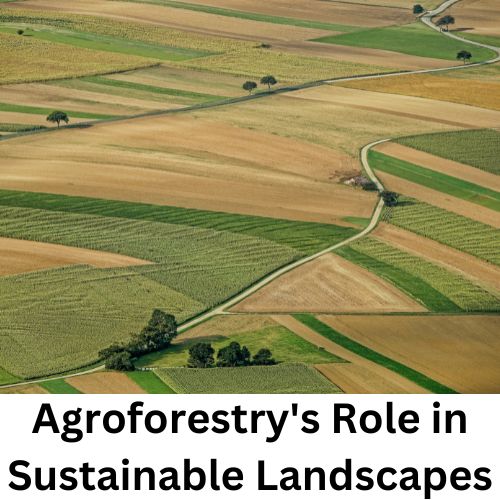Introduction
In an era where environmental sustainability is a global imperative, agroforestry emerges as a beacon of hope for reshaping our future. Agroforestry, the art of integrating trees and shrubs into agricultural landscapes, offers a multifaceted solution that promotes ecological resilience, enhances biodiversity, and sustains livelihoods. In this blog post, we will explore the pivotal role of agroforestry in creating sustainable landscapes and discuss how it contributes to addressing pressing global challenges.
Chapter 1: Agroforestry Unveiled
Before delving into the role of agroforestry in sustainable landscapes, let’s begin by understanding what agroforestry entails and its underlying principles.
1.1. What is Agroforestry?
Agroforestry is a holistic land management approach that combines the cultivation of trees or woody perennials with traditional agricultural practices. It encompasses diverse systems and practices tailored to local ecological conditions, making it adaptable and highly effective in various contexts.
1.2. The Principles of Agroforestry
Agroforestry systems are built on the following core principles:
1.2.1. Biodiversity: Agroforestry promotes biodiversity by creating diverse and interconnected habitats for plants, animals, and microorganisms.
1.2.2. Sustainability: Agroforestry emphasizes the sustainable use of natural resources, ensuring that the land remains productive for future generations.
1.2.3. Economic Viability: Agroforestry systems are designed to benefit farmers economically, making it a viable and attractive option for land use.
Chapter 2: Agroforestry’s Role in Sustainable Landscapes
Now that we have a foundational understanding of agroforestry, let’s explore how it contributes to creating sustainable landscapes.
2.1. Biodiversity Conservation
Agroforestry systems act as vital refuges for biodiversity. By incorporating a diverse range of tree species, these systems provide shelter, food, and breeding grounds for wildlife. This promotes the conservation of native flora and fauna, making agroforestry an essential tool in the fight against biodiversity loss.
2.2. Soil Health and Fertility
One of the critical aspects of sustainability in agriculture is maintaining soil health and fertility. Agroforestry systems excel in this regard:
2.2.1. Nutrient Cycling: Trees in agroforestry systems contribute organic matter and nutrients to the soil, enhancing its fertility.
2.2.2. Erosion Control: Tree roots bind soil particles, reducing erosion and protecting valuable topsoil.
2.2.3. Improved Soil Structure: Trees can enhance soil structure, making it more resilient to compaction and erosion.
2.3. Climate Resilience
As climate change disrupts weather patterns and increases the frequency of extreme events, agroforestry systems offer resilience:
2.3.1. Carbon Sequestration: Trees capture and store carbon dioxide, mitigating the impacts of greenhouse gas emissions and helping combat climate change.
2.3.2. Microclimate Modification: Trees modify the local microclimate, reducing the risk of frost, enhancing moisture retention, and creating stable growing conditions.
2.4. Water Management
Efficient water management is crucial for sustainable agriculture. Agroforestry helps:
2.4.1. Reduce Water Runoff: Trees and shrubs intercept rainfall, reducing runoff and soil erosion.
2.4.2. Enhance Water Quality: Agroforestry systems filter pollutants from surface runoff, improving water quality in streams and rivers.
Chapter 3: Economic and Livelihood Benefits
Agroforestry doesn’t just benefit the environment; it also offers economic advantages that support livelihoods and rural communities.
3.1. Diverse Income Streams
Farmers practicing agroforestry benefit from diversified income sources:
3.1.1. Timber and Non-Timber Forest Products: Trees can be harvested for timber, while non-timber forest products like fruits, nuts, and medicinal herbs provide additional revenue.
3.1.2. Traditional Crops: Agroforestry systems can boost the yields of traditional crops, ensuring stable income from agricultural production.
3.2. Reduced Input Costs
Agroforestry can lead to cost savings for farmers:
3.2.1. Natural Pest Control: Trees create habitats for beneficial insects and birds that help control pests, reducing the need for chemical pesticides.
3.2.2. Soil Health Improvement: Improved soil fertility reduces the need for synthetic fertilizers.
3.2.3. Water Efficiency: Trees’ shade and windbreaks reduce crop water requirements, lowering irrigation costs.
3.3. Resilience to Market Fluctuations
Diversifying income sources in agroforestry systems helps farmers withstand market fluctuations and economic uncertainties. With multiple revenue streams, they are less vulnerable to the price volatility of a single crop or product.
Chapter 4: Agroforestry Worldwide
Agroforestry isn’t limited to specific regions; it is a global practice that takes on diverse forms in various landscapes:
4.1. Tropical Agroforestry
In tropical regions, agroforestry systems often involve mixed plantations of valuable timber species, fruit trees, and traditional crops. These systems support local livelihoods, provide sustainable timber resources, and protect biodiversity.
4.2. Temperate Agroforestry
In temperate climates, agroforestry may include alley cropping, silvopasture, or windbreaks. These systems help mitigate extreme weather conditions, provide forage for livestock, and create diverse landscapes.
4.3. Dryland Agroforestry
Agroforestry is also relevant in arid and semi-arid regions, where it helps conserve water, improve soil fertility, and create oases of productivity amid challenging conditions.
Chapter 5: Policy and Education
For agroforestry to play a significant role in shaping sustainable landscapes, supportive policies and educational efforts are crucial:
5.1. Policy Support
Governments and institutions should incentivize agroforestry through policies that promote sustainable land use, provide financial incentives, and remove barriers to adoption.
5.2. Education and Training
Farmers and landowners should receive education and training on agroforestry practices, ensuring they have the knowledge and skills to implement and manage these systems effectively.
Conclusion
Agroforestry stands as a powerful tool in shaping the future of sustainable landscapes. Its ability to reconcile ecological resilience with economic viability and livelihood support makes it a model for land management in the 21st century. By embracing agroforestry, we can pave the way for a more sustainable and prosperous future where landscapes thrive, biodiversity flourishes, and communities prosper.
